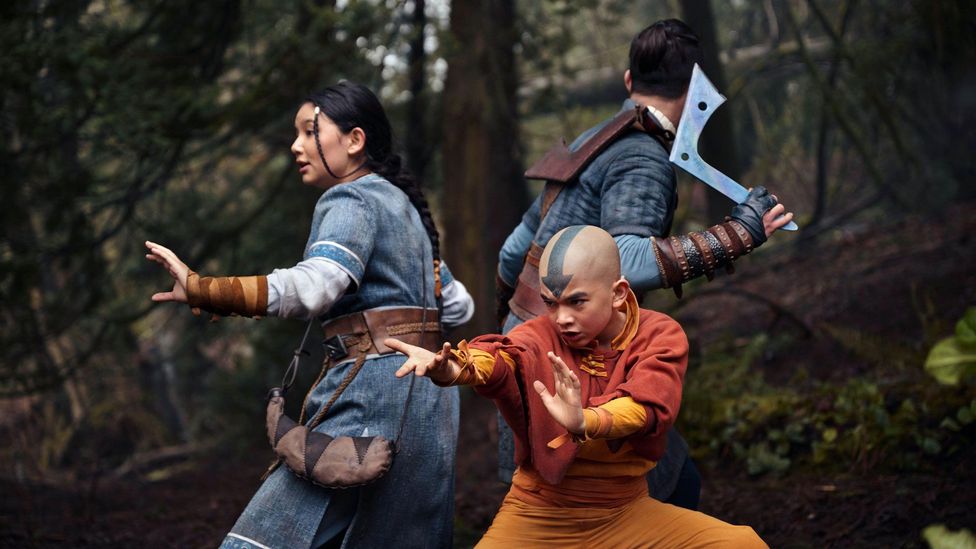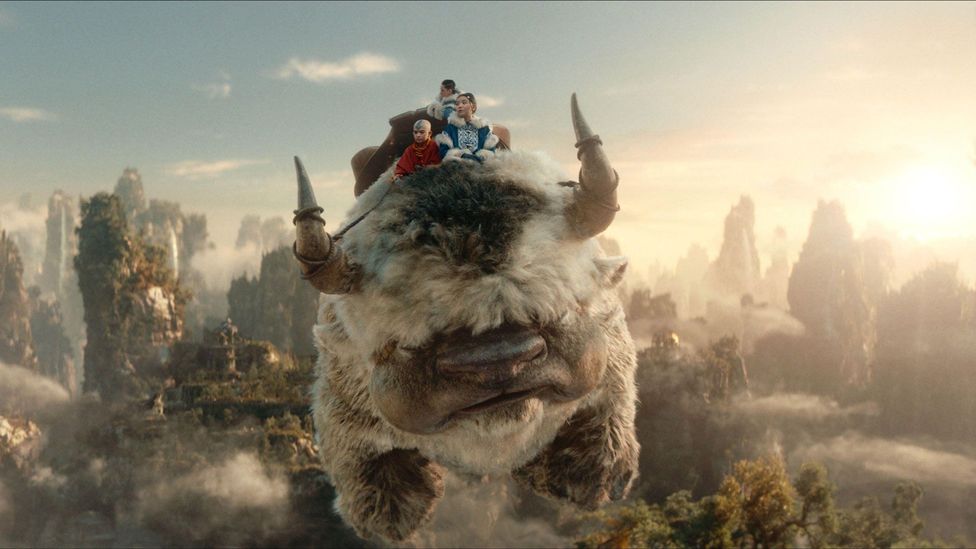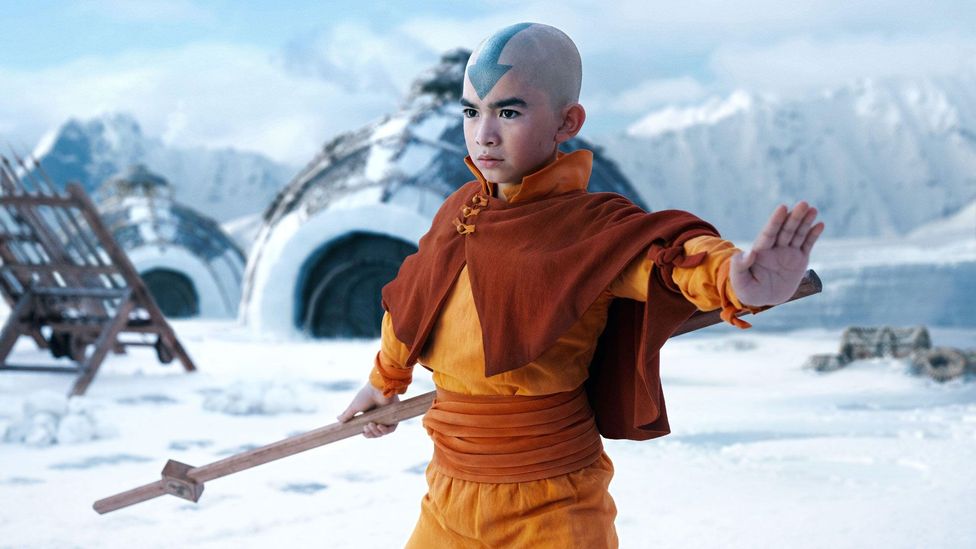Watching the Netflix-produced, live-action remake of hugely-popular noughties animation Avatar: The Last Airbender brings to mind an astute recent piece by Dazed writer James Greig, which posited that pop culture is pandering to people's desire to remain in a perpetual childhood. At their worst, remakes of beloved works indulge this infantilising impulse, satisfying urges to make everything old – that audiences loved when they were younger – new again. Based on the show created by by Michael Dante DiMartino and Bryan Konietzko for Nickelodeon – which imagined an intricate fantasy world with different nations named after the elements fire, earth, water and air, and select people with the ability to "bend" them – The Last Airbender is a rather unholy combination of this cheaply-nostalgic drive and the worst vices of live-action remakes of animations.
More like this:
– True Detective's unsolved mysteries were welcome
– What we know about Squid Games series two
– Nine TV series to watch this February
Though remakes in general are not always a bad or ignoble idea, live-action remakes of animations often feel doomed from the start. Right away, there's a specific tension that comes from replicating drawings in live-action. Animation has visual flexibility; characters can transform in myriad ways as the scene requires. Therefore the same scenes or character design choices won't necessarily work in the same way, because there are two kinds of expression at work; the animation needs to be adapted, not just lifted.

(Credit: Netflix/Alamy)
It's unfortunate, then, that this Airbender feels designed simply to be "that show you remember, but what if it was real", trading in the original's visual expressiveness for more dour scenery as it plays up the harshness of its war story – a story which might have more of an impact if everything didn't feel so detached. All the lavish VFX in the world can't undo boring direction, its action sequences made with a confounding sense of space, its long conversations full of listless shots against blurry, unconvincing backdrops, the lines delivered with rather subdued energy that the camerawork doesn't compensate for or emphasise in a meaningful way. Even at its most expensive and polished, the show lacks a sense of visual character that the animation had in spades. It feels like someone transported Airbender over to some kind of generic "Netflix World" – and this isn't the first time that has happened with beloved animations.
The streamer has made it something of a business practice to buy up licenses of popular animation and turn them into live-action series, with an adaptation of Mobile Suit Gundam still on the way. But Netflix's 2021 version of anime Cowboy Bebop, for example, felt like it used the original as a worksheet, rather than clocking its influences (film noir, westerns and yakuza flicks among them) and adding some of its own. Like Airbender, it would constantly and aggressively call back to its animated predecessor without truly engaging with it, floundering in its attempt to distill the original's larger-than-life characters into what has become the streamer's modus operandi: a coupling of muted colour palettes with flat lighting and composition, and an assumption that familiar imagery will conjure the same feeling, regardless of style.
Avatar: The Last Airbender barely even attempts to reevaluate the material it's recreating, In some respects, it is regresses from it
Airbender barely even attempts to reevaluate the material it's recreating, In some respects, it regresses from it. The second episode, Warrior, is the most egregious example, replicating a story from the animation but avoiding depicting the Water tribe warrior Sokka as sexist. It takes away the challenge to his belief system, and gives the impression that the writers don't trust that the in-fact older audience – which it seems to be targeting through its more severe tone – can understand the nuances of the story being told.
It's representative of the show's approach, visually and tonally styling itself as a more mature take on the same material, while it balks at anything resembling moral ambiguity. As a result this version makes little justification for itself. Does it exist it to bring on board a new audience? Yet the original is already massively popular (it's still sitting comfortably at number seven in IMDb's Top 250 TV shows ever, as rated by the site's users) and available on the very same service.
The live-action remakes that have got it right
When it comes to live-action remakes of popular animations, a handful of people have got them right. The 2008 film version of Manga series Speed Racer, although a commercial flop, was artistically rich. It carried forward the stylings of the anime into its own visual language, with Lana and Lily Wachowski saying in interviews that they applied the principles of cubist art to their approach. It had an idea about what Speed Racer is, and used strong stylisation to overcome that gap between the cartoonish and the real that proves fatal for so many animation to live-action remakes.

(Credit: Netflix/Alamy)
Even Netflix has got it right on occasion. Last year's One Piece, based on the pirate-themed manga series, allowed itself to embrace the earnestness of the original and the writer Eiichiro Oda's cartoonish aesthetics, and the show has gone over well with new fans and old fans alike. It felt sincere, where Airbender feels cynical.
Indeed as much as remakes more generally may often be sneered at by critics and general audiences alike, the remake doesn't necessarily have to be a product of moribund nostalgia. That much is true across mediums: only this coming week, the second instalment of the Final Fantasy VII Remake trilogy, Final Fantasy VII Rebirth, is being released on PlayStation 5. Game remakes have different motivations – the promise of improved graphics and mechanics, and the originals' scarce accessibility among them. But the Final Fantasy VII Remake games' narrative invention and admirably wild twists stand out in relation to the live-action Airbender's dull facsimile. The characters in the FFVII Remake instalments fight against the idea that their path is predetermined – and so the games confront the idea of the remake itself. Why retread old ground, it asks? If you already know where a story's path leads, wouldn't it be more exciting to see a new one?
There is a place for both remakes, and live-action takes on animation, but only if they have a clear vision of why the thing exists, beyond blankly giving people more of what they liked. The new take on Avatar: The Last Airbender doesn't work as an entity of its own, not just due to its strange, stilted visual appropriation of animated craft, but also because of its refusal to move on from the past – in other words, it's a show that has resolutely failed to grow up.
Avatar: The Last Airbender is streaming on Netflix internationally now
If you liked this story, sign up for The Essential List newsletter – a handpicked selection of features, videos and can't-miss news delivered to your inbox every Friday.
If you would like to comment on this story or anything else you have seen on BBC Culture, head over to our Facebook page or message us on Twitter.
